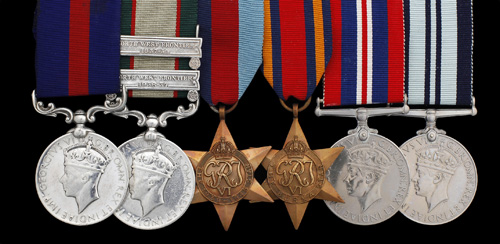
Auction: 1005 - Orders, Decorations, Campaign Medals & Militaria
Lot: 20
The Superb I.D.S.M. Group of Six to Havildar Khan Zaman, Indian Parachute Regiment, For His Gallantry During the Battle of Sangshak, March 1944, Where Despite Being Wounded he Led His Men in Fighting That Was ´Probably the Fiercest of the Whole Burma Campaign´; Taken Prisoner He Organized Two Escape Parties, and Then Successfully Escaped Himself, Leading Eleven Others to Safety a) Indian Distinguished Service Medal, G.VI.R. (90 Hav, Khan Zaman, 152 Ind Parachute R) b) India General Service 1936-39, two clasps, North West Frontier 1936-37, North West Frontier 1937-39 (14704 Rfm. Khan Zaman Khan, 3-6 Raj. Rif) c) 1939-1945 Star d) Burma Star e) War Medal f) India Service Medal, generally nearly very fine or better, together with an Indian Parachute Regiment cap badge and cloth insignia; and a comprehensive file of research (6) Estimate £ 1,500-2,000 I.D.S.M. London Gazette 1.1.1945 No.90 Havildar Khan Zaman, 152 Parachute Battalion, Indian Army The Recommendation states: ´Havildar Khan Zaman was in action with his platoon for five days continuously towards the end of March 1944. They were cut off from the main perimeter by a very strong force of Japs and they had very little food and even less rest. Khan Zaman was wounded but he fought on and kept his men fighting. Eventually the position was in danger of being overrun and the platoon was ordered to withdraw. There was not sufficient time to take away all the severely wounded and Havildar Khan Zaman was captured. During nearly all the whole of his captivity he was in hospital but still managed to organize two escape parties, instructing the men to get back to Imphal and give as much information as possible to the nearest British H.Q. As soon as he was strong enough himself he escaped, and successfully led eleven others to safety. This Havildar showed magnificent courage and was an inspiration to his men not only in action but during the time of his captivity and it is recommended that he be awarded the Indian Distinguished Service Medal 90 Havildar Khan Zaman, I.D.S.M., born Rokhri, Mianwali, India (now Pakistan); enlisted in the 3rd Battalion, 6th Rajputana Rifles, 23.11.1933; joined the Parachute Battalion, 16.7.1940. Battle of Sangshak By March 1944, Khan Zaman was serving with 152 Parachute Battalion, as part of 50 Brigade, made up of 152 and 153 Parachute Battalions, a medium machine-gun company, a squadron of sappers, and a field ambulance. On 10th March the Brigade, under the command of Brigadier M. Hope-Thompson, was ordered to move to Imphal, to relieve 49 Brigade. Owing to the difficult nature of the terrain, and the scarcity of motor transport, the move took several days, and was further complicated by the arrival on the scene of the enemy. 152 Battalion, under the command of Lieutenant-Colonel P. Hopkinson, arrived at Sangshak, 25 miles from Imphal, on the afternoon of the 14th March. The next five days passed uneventfully, with forward positions completed, obstacles erected, and reserve ammunition and water stocked up. On the 19th March word reached the Battalion that a force of between 700 and 900 of the enemy was advancing on their position. That night the enemy made repeated efforts to penetrate the perimeter, but were twice driven off with the cost of several casualties on both sides. By dawn the situation had become serious. Rather than keep this small force dispersed over the countryside it was decided it should fall back on the village of Sangshak. For the next five days the battle went on almost continuously, with the Japanese shelling and mortaring the defenders. Food, water, and ammunition were all urgently wanted, and many of the defenders were suffering from severe exhaustion. On the 26th March the enemy put in a strong attack on that part of the perimeter held by the 152nd Battalion, which had been considerably weakened by casualties since the fighting had begun, and was now in a very bad way, with all their company commanders and most of their platoon commanders dead or dying. The Japanese were successful in making a deep penetration into the village, which meant that the hospital had to be moved, and several guns and some of the mortars were put out of action. Rallied by their officers, 153 Battalion counter-attacked, and most of the lost ground was retaken and the perimeter restored. However, at 6:30 that evening a message was received from Divisional Headquarters: ´Fight your way out. Go south then west. Air and transport on look-out for you. Good luck, our thoughts are with you.´ The most immediate problem was what to do with the wounded, by now numbering more than 450. In the end it was decided that those who could make the journey on foot should do so, whilst those unable to walk would be left behind. At 10:30 that night the move began in complete darkness. The Japanese, taken by surprise, made no attempt to follow, and three days later the Brigade arrived in Imphal. By successfully holding up the Japanese at Sangshak for a week, the enemy´s plans had been thrown out of gear. In addition, the delay allowed for more reinforcements to arrive in Imphal, and had a significant bearing on the success of the entire Burma Campaign. Although all the records relating to the 152 Parachute Battalion were subsequently split up and destroyed following Partition, it is probable that Khan Zaman was serving in A Company, and, because of his injuries, was one of those left behind at Sangshak to be captured by the Japanese. Out of an initial strength of 31 Officers and approximately 550 Indian V.C.O.s and other ranks, the 152nd Battalion suffered 23 Officers and 335 V.C.O.s and other ranks killed, wounded, or missing, in fighting that was ´probably the fiercest of the whole Burma Campaign´ (letter from the recipient´s Commanding Officer, Brigadier P. Hopkinson, M.B.E., included with lot refers).
Sold for
£4,200




